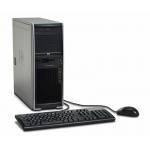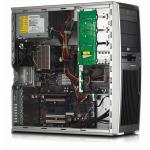Perfect for MCAD
The HP xw4400 Workstation is the company's first Core 2 Duo-based workstation.
Latest News
December 4, 2001
By David Cohn
While the latest high-end workstations from HP — the Intel “Woodcrest” Xeon-based xw8400 (see the DE review, September 2006) and AMD Opteron-equipped xw9400 (see the DE review, November 2006) — certainly deliver the maximum performance currently available, they are probably beyond the budgets of the average MCAD user and overkill for most midrange MCAD applications.
A more likely candidate for most readers is the HP xw4400 workstation, which is the first workstation we’ve received based on the new Intel Core 2 Duo “Conroe” processor and 975X Express chipset.
The HP xw4400 is the successor to last year’s xw4300 workstation. That system was based on Intel’s dual-core Pentium D processor, the first with two CPU cores, each with its own 1MB L2 cache on a single piece of silicon. But Pentium D used Intel’s older Netburst architecture, which relied largely on clock speed for performance. Core 2 Duo uses Intel’s new Core microarchitecture, which focuses on performance per clock cycle rather than raw speed.
 |
| The HP xw4400 Workstation |
Intel has been extremely bullish about its Core 2 Duo CPUs, claiming 40 percent faster performance while at the same time noting a 40 percent decrease in power consumption. Like its predecessor, the new CPU incorporates two independent processor cores in one physical package, but this time each has access to a shared 4MB L2 cache dynamically allocated to each core based on workload. The CPU also uses a 1066MHz front-side bus (versus 800MHz with the Pentium D) and can complete up to four full instructions simultaneously.
The xw4400 is housed in the now familiar HP black and gray convertible minitower case. No tools are required to open or upgrade the workstation and the system easily converts from tower to desktop by rotating the optical drive bays. The front panel provides two USB 2.0 connectors, headphone and microphone jacks, and an optional FireWire connector. The rear panel adds five more USB connectors and there’s one more inside the case on the motherboard so you can install a USB-based dongle where it can’t be tampered with.
The rear panel also sports a single 9-pin serial port (a second serial port and two more FireWire ports are optional), a 25-pin parallel port, PS/2 keyboard and mouse ports, an RJ45 LAN connector for the integrated Broadcom 5755 NetXtreme Gigabit network, and audio-in, audio-out, and microphone jacks. Like other HP workstations, the sound system supports jack retasking, which allows the computer to sense which device is plugged into an audio jack so that any jack can act as an audio-in, audio-out, microphone, or headphone jack.
As we’ve come to expect from HP, there’s lots of room for expansion inside the well-organized case. The HP motherboard provides four DIMM sockets and can accommodate up to 8GB of memory using 2GB DIMMs. Our evaluation unit came with 2GB of DDR2-SDRAM installed as two 1GB 667MHz ECC unbuffered modules. The motherboard also provides an integrated serial ATA 3GBps RAID-capable hard-drive controller that can support up to four SATA hard drives. There’s also an optional serial attached SCSI (SAS) controller available. Our evaluation unit came with a Seagate 160GB 7,200 SATA drive installed in one of the two available internal drive bays. The front panel provides three 5.25-inch drive bays for removable media, one of which was filled with a DVD+/-RW dual-layer drive with HP Lightscribe technology, and a single 3.5-inch bay that contained a floppy drive.
 |
| A look inside of the HP xw4400 Workstation. |
The motherboard provides a total of six full-length slots: a single PCI Express x16 graphics slot, three legacy PCI slots (one of which contained the optional FireWire board), a PCI Express x16 slot (x4 electrically), and a PCI Express x1 slot. The graphics card slot was filled with an NVIDIA Quadro FX 1500 graphics accelerator with 256MB of video memory. The 460-watt power supply supports the system’s expansion capabilities, and the xw4400 runs very quietly in spite of the 3-inch fan on the rear panel, 2.5-inch fan on the CPU, and the fan in the power supply.
Surprising Results
Although equipped with a midrange graphics accelerator rather than the high-end boards we received in the xw8400 and xw9400 workstations, the xw4400 performed extremely well during our testing, clearly validating the purported performance benefits of Intel’s Core 2 Duo architecture. (Click here to download an XLS file of results.)
We were actually surprised by the xw4400’s results on the SPECopc viewperf graphics benchmark. While we could predict that the xw4400 would outperform last year’s xw4300 — it beat it by an average of 72 percent — we weren’t expecting its 21 percent average improvement over the xw9400. Even when compared to the HP xw8400, the xw4400 lagged by only 11 percent.
On the SPECapc SolidWorks benchmark, which is more of a real-world test (and breaks out graphics, CPU, and I/O performance separately from the overall score), the results were also somewhat surprising. The xw4400 completed the test in just over 203 seconds, 50 percent faster than last year’s xw4300 and 12 percent faster than the Opteron-powered xw9400. Again, the xw4400 lagged only 10 percent behind the high-end xw8400 workstation. The improved I/O and graphics performance of the system definitely tipped the scale, since the system’s CPU results were 2 percent behind those of the xw9400’s faster Opteron processor and a full 23 percent slower than the 3.0GHz Intel Xeon processor in the HP xw8400.
Readers should note, of course, that the xw8400 and xw9400 support two CPUs and lots more memory, and will clearly outperform the xw4400 when doing serious number crunching, such as FEA and CFD analysis, 3D rendering, and video encoding, or when dealing with very large datasets. Standard benchmarks simply don’t reveal the benefits of multiple processors. But those high-end systems are beyond most users’ needs for day-to-day MCAD applications.
As usual, HP rounds out the xw4400 with its excellent 104-key keyboard and a 2-button wheel mouse. Windows XP Professional 32-bit version came preinstalled. The 64-bit version of Windows and Red Hat Enterprise Linux (32- or 64-bit) are also available. Our Windows-based system also included the HP Performance Tuning Framework. The xw4400 system is backed by a three-year warranty that includes parts, labor, and on-site service. And, like other HP workstations, most MCAD and DCC applications are tested and certified on the xw4400.
In addition to the performance advantage of Intel’s new Core 2 Duo processors, the new CPUs cost less than their predecessors. The HP xw4400 workstation has a starting price of only $849, albeit with an older Pentium D CPU and a 2D graphics board. But even as equipped, our evaluation unit costs just $2,599, making the HP xw4400 a perfect choice for midrange MCAD.
David Cohn is a computer consultant and technical writer based in Bellingham, WA, and has been benchmarking PCs since 1984. He’s a contributing editor to Desktop Engineering, an applications engineer with The PPI Group, the former editor-in-chief of Engineering Automation Report and CADCAMNet, and the author of more than a dozen books. You can contact him via e-mail at [email protected] or visit his website at www.dscohn.com. Or send your comments about this article through e-mail by clicking here. Please reference “HP xw4400 Review” in your message.
HP xw4400 At A Glance
HP
Houston, TX
> Price: $2,599 as tested ($849 base price)
> Size: 6.7 x 18 x 17.7 inches (WxDxH) tower
> Weight: 34 pounds
> CPU: Intel Core 2 Duo 6700 2.67GHz
> Memory: 2GB (8GB max)
> Graphics: NVIDIA Quadro FX 1500
> Hard Disk: Seagate 160GB 7,200 rpm SATA
> Floppy: 3.5-inch floppy
> Optical: DVD+/-RW Dual-Layer Lightscribe
> Audio: integrated Realtek audio w/ microphone, line-in, headphone, line-out jacks and jack retasking
> Network: integrated Broadcom 5755 NetXtreme Gigabit LAN
> Modem: none
> Other: one 9-pin serial, one 25-pin parallel, seven external and one internal USB 2.0, two IEEE 1394 FireWire, PS/2 keyboard, PS/2 mouse
> Keyboard: 104-key HP keyboard
> Pointing device: two-button HP scroll mouse
Subscribe to our FREE magazine, FREE email newsletters or both!
Latest News
About the Author
David Cohn is a consultant and technical writer based in Bellingham, WA, and has been benchmarking PCs since 1984. He is a Contributing Editor to Digital Engineering, the former senior content manager at 4D Technologies, and the author of more than a dozen books. Email at [email protected] or visit his website at www.dscohn.com.
Follow DE





